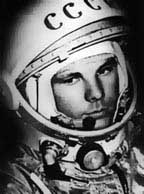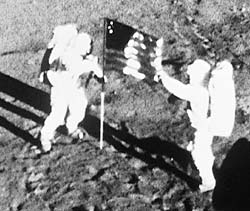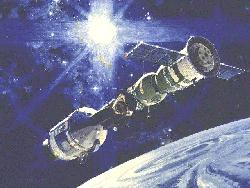Space Milestones 1926 March 16. Robert H. Goddard launches the first successful liquid-propellant rocket in Auburn, Massachusetts. The flight achieved and altitude of 41 feet (12 meters) and lasted for only 2.5 seconds.  1957 1957
October 4. The Soviet Union successfully placed the world's first artificial satellite, Sputnik 1, into Earth orbit. Sputnik 1, which weighted in at 184 pounds, had two radio transmitters that broadcasted a "beep" tone to the Earth. November 3. Laika becomes the first animal to be launched into orbit by Sputnik 2. Laika lives in space for seven days providing animals and humans can survive in space. 1958 January 31. Explorer 1 became America's first satellite and was in direct response to the successful mission of its Soviet predecessor Sputnik 1. Explorer 1 carried an instrument package developed under the direction of Professor James A. Van Allen. The instrument package along with Explorer 3 provided evidence that the Earth is surrounded by intense bands of radiation, which are now called the Van Allen Radiation Belts. October 1. The National Aeronautics and Space Agency (NASA) is created in response to the Soviet Union's launch of Sputnik 1. NASA inherits the responsibilities of the former National Advisory Committee for Aeronautics (NACA).  1961 1961
April 12. Soviet Cosmonaut Yuri Gagarin becomes the first human in space by partaking in a spaceflight aboard the Vostok 1. The flight lasts less than 2 hours and consists of only one orbit. May 5. American Astronaut Alan Shepard becomes the first American in space with his suborbital flight aboard Freedom 7, which achieved an altitude of 100 miles (160 kilometers). May 25. American President John F. Kennedy vows to send men to the moon and back by the end of the decade. 1962 February 20. American Astronaut John Glenn becomes the first American to orbit the Earth. The flight lasted 4 hours and 55 minutes aboard Friendship 7. December 14. On this date, the Mariner 2 spacecraft radioed back scientific information from the vicinity of another planet for the first time. Mariner 2 passed within 21,600 miles (34,800 kilometers) of Venus and utilized its six scientific instruments to discover that Venus is a very hot planet that does not have any measurable magnetic fields or radiation belts. 1963 June 16. Soviet Union Cosmonaut Valentian Tereshkova becomes the first woman in space. 1965 March 18. Soviet Union Cosmonaut Aleksei Leonov takes the first space walk, which lasted for 10 minutes outside Voskhod 2. June 3. American Astronaut Edward H. White II becomes the first American to conduct an Extra Vehicular Activity (EVA). White floated outside his Gemini IV spacecraft for 22 minutes. 1966 March 16. Gemini VIII makes the first successful docking with another space vehicle. Gemini VIII docks with an unmanned Agena rocket stage. However, Gemini VIII later suffers malfunctions and undergoes America's first emergency landing. 1967 January 27. A freak flash fire occurs during a launch rehearsal taking place on Launch Pad 34-A at the Kennedy Space Center, in Florida. The fire engulfs the Apollo 1 command module and quickly kills Astronauts Virgil "Gus" Grissom, Edward White II, and Roger Chaffee. April 24. Cosmonaut Vladimir Komarov dies when his Soyuz 1 crashes upon re-entry into the Earth's atmosphere. Vladimir was the first human to die during a spaceflight mission. 1968 April 3. Stanley Kubrick's film 2001: A Space Odyssey, which is based upon Arthur C. Clarke's short story The Sentinel, is released in theaters. December 21. Apollo 8 launches from the Kennedy Space Center, Florida on the way to the first manned mission to orbit the Moon. American Astronauts Frank Borman, Jim Lovell, and Bill Anders conduct the first human journey beyond the Earth's orbit.  1969 1969
July 20. Apollo 11 "That's one small step for (a) man, one giant leap for mankind." Astronauts Neil Armstrong and Edwin "Buzz" Aldrin become the first men to set foot upon a celestial body besides the Earth, the Moon, when they leave the "Columbia." Michael Collins remains in lunar orbit while the duo walks upon the lunar surface. 1970 April 13. Apollo 13 experiences a life threatening situation when an oxygen tank in the Service Module (SM) raptures. The crew is forced to abort its mission and depend upon the Lunar Module (LM). The crew safely returns to Earth four days later. 1971 April 19. The Soviet Union launches the first space station into Earth orbit. The orbiting laboratory is named Salyut 1. June 30. The Soviet Union suffers a major loss when the first crew of the Salyut 1 perishes when the spacecraft that was bringing the crew back to Earth suddenly undergoes depressurization during re-entry aboard Soyuz 11. 1972 December 19. Gene Cernan and Harrison Schmitt become the final astronauts to walk on the Moon. Human expeditions beyond Earth orbit cease as Apollo 17 safely returns to the planet Earth. 1973 May 14. Skylab 1, the first American space station, is launched into space. The first of three crews arrives 11 days later to inhabit the station that orbits the Earth at an altitude of 271 miles. The space station is abandoned on February 8, 1974.  1975 1975
July 17. During the height of the Cold War, three American Astronauts and two Soviet Union Cosmonauts successfully dock in the joint Apollo-Soyuz mission. This was the first joint international manned space mission. 1976 July 20. Viking 1 becomes the first spacecraft to land on an another planet. Instruments aboard Viking 1 provided valuable information about the Martian atmosphere and surface, however, biological experiments were unable to conclusively detect any biological or organic materials. Viking 1's sister ship, Viking 2, safely lands on the Martian surface on September 9th. 1979 March 5. Voyager 1 makes its closest approach to Jupiter relaying images and data about the planet and its moons, while Voyager 2 follows suite four months later. July 11. Skylab 1 falls out of the sky and crashes and scatters debris across southeastern Indian Ocean to western Australia. September. The Right Stuff, by Tom Wolfe, is first published and conveys the earliest days of the American manned space program. 1981 April 12. The Space Shuttle Columbia rumbles off its Florida pad to on the inaugural launch of the Space Transportation System (STS), which is the first reusable manned spacecraft. August 25. Voyager 2 zooms by Saturn beaming valuable data and spectacular pictures of the planet's rings and moons. 1983 June. Pioneer 10 ventures past the planets in our Solar System. Launched on March 3, 1972, Pioneer 10 encountered the planet Jupiter, where Pioneer 10 took close-up pictures and provided data about its atmosphere, magnetic fields, and radiation belts. June 18. U.S. Astronaut Sally Ride become the U.S. first woman in space. 1984 February 7. Astronauts Bruce McCandless and Robert Stewart utilize jet backpacks to take the first untethered space walk. April 10-12. U.S. Astronauts aboard the Space Shuttle Challenger perform the first in-orbit retrieval and repair mission on the failing Solar Max satellite. 1986 January 28. The Space Shuttle Challenger, on mission STS-54L, explodes only 73 seconds after lift-off instantly killing all seven astronauts. February 20. The Soviet space station Mir is successfully launched into Earth orbit. 1987 February 8. The first crew of the Mir arrives at the space station. The Mir space station becomes the first continuously inhabited space station. 1989 May 4. The Magellan spacecraft is launched on a radar mapping mission to Venus. The Magellan becomes the first spacecraft to be launched from the Space Shuttle via Atlantis. 1990 April 24. Hubble Space Telescope (HST) is successfully placed into Earth orbit via the Space Shuttle Discovery. Astronauts almost instantly realized the main optical mirror on the HST is misshaped. August 10. The Magellan spacecraft insets into orbit around Venus and starts relaying radar images of the planet's surface as well as other data. 1993 December 4-10. The astronomy's world blemish becomes its crown jewel when Astronauts successful capture and repair the Hubble Space Telescope. 1994 February 3. Cosmonaut Sergei Krikalev becomes the first Russian to fly aboard a U.S. spacecraft. 1995 June 27. Space Shuttle Atlantis launches from the Kennedy Space Center (KSC) becoming the first Space Shuttle to dock with the Russian Space Station Mir. This was America's 100th manned space mission. December 7. The Galileo space probe reaches Jupiter to begin an extended mission after a six-year journey. 1997 July 4. The highlight of the Pathfinder mission takes place when the Sojouner rover lands on Mars and begins to roaming the planet's surface. 1998 November 20. The first component of the International Space Station (ISS) is launched into Low Earth Orbit (LEO). 2000 November 2. The United States and Russia along with multiple countries initiate a permanent human presence in space as Bill Shepherd, Yuri Gidzenko, and Sergei Krikalev become the first residents of the International Space Station. 2001 April 28. California investor Dennis Tito becomes the first space tourist as he pays $20 million to partake a nine-day visit to the International Space Station. 2003 February 1. The Space Shuttle Columbia disintegrates upon re-entry after a successful scientific microgravity mission. All seven crew members are lost aboard the STS-107 mission. 2004  January 3. The Mars Exploration Rover (MER) Spirit lands at Gusev Crater on Mars. Three weeks later, Spirit's sister ship Opportunity touches down at Meridiani Planum to begin further exploration of the Martian surface. The two rovers for the first time conclude that Mars was once cover with liquid water. January 3. The Mars Exploration Rover (MER) Spirit lands at Gusev Crater on Mars. Three weeks later, Spirit's sister ship Opportunity touches down at Meridiani Planum to begin further exploration of the Martian surface. The two rovers for the first time conclude that Mars was once cover with liquid water.
June 21. Designed by Burt Rutan, SpaceShipOne becomes the first privately manned mission to space. SpaceShipOne has several more successful flights and takes home the Ansari X-Prize on October 4th of the same year. |